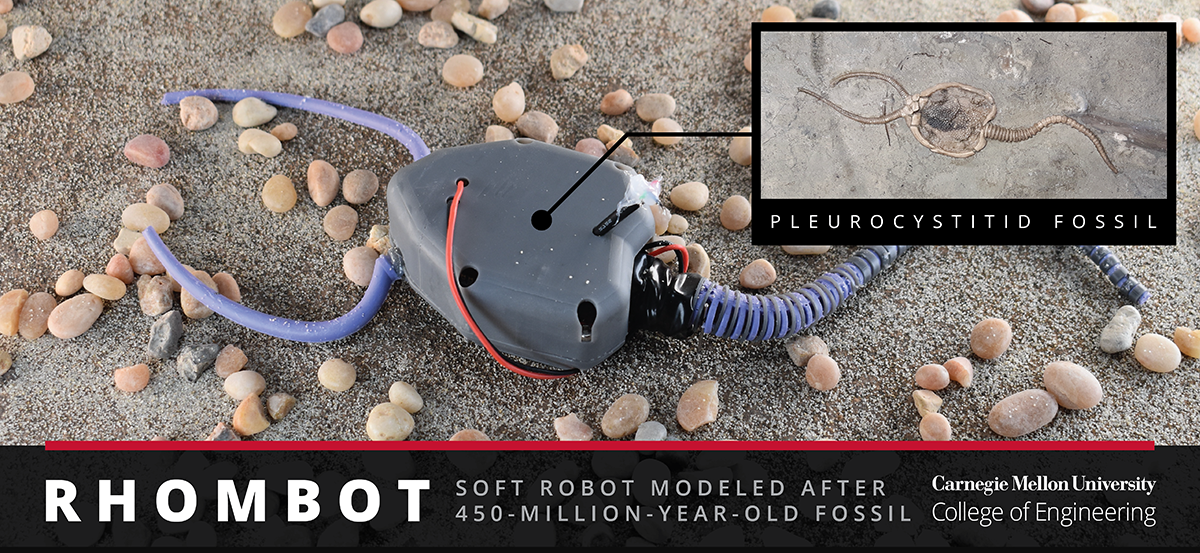
Image Credit: Carnegie Mellon University
These creatures are thought to be among the earliest echinoderms to exhibit movement through a muscular stem.
Humans have been inhabiting Earth for approximately 300,000 years, a seemingly vast expanse of time that, when viewed within the context of the planet's history, appears rather recent. To put it into perspective, the tenure on Earth accounts for a mere 0.007% of the entire timeline.
Consequently, the contemporary animal kingdom, which greatly informs the comprehension of evolution and serves as an inspiration for today’s mechanical systems, represents just a fraction of the multitude of creatures that have thrived throughout history.
In an effort to broaden the understanding of animal design and locomotion, researchers from Carnegie Mellon University's Department of Mechanical Engineering, in collaboration with paleontologists from Spain and Poland, are pioneering a novel field called Paleobionics.
This emerging discipline focuses on utilizing Softbotics, a domain of robotics incorporating flexible electronics and soft materials, to unravel the biomechanical drivers of evolution by studying extinct organisms.
Our goal is to use Softbotics to bring biological systems back to life, in the sense that we can mimic them to understand how they operated.
Phil LeDuc, Professor, Mechanical Engineering, Carnegie Mellon University
Under the guidance of LeDuc and Carmel Majidi, a research team has breathed fresh life into the ancient marine organism known as pleurocystitid, which existed almost 450 million years ago.
Belonging to the echinoderm class, which includes contemporary creatures like starfish and sea urchins, pleurocystitids were among the earliest echinoderms with the ability to move through a muscular stem. Despite lacking a modern-day counterpart, paleontologists have been intrigued by pleurocystitids due to their pivotal role in the evolution of echinoderms.
“Softbotics is another approach to inform science using soft materials to construct flexible robot limbs and appendages. A lot of fundamental principles of biology and nature can only fully be explained if we look back at the evolutionary timeline of how animals evolved. We are building robot analogs to study how locomotion has changed,” explained Majidi, lead author and professor of mechanical engineering.
The team employed fossil data as a blueprint for their design, utilizing a combination of 3D printed components and polymers to replicate the pliable, columnar structure of the organism’s mobile appendage in constructing the robot.
Their experiments revealed that pleurocystitids probably navigated the seafloor by employing a stem that propelled the creature forward, and they ascertained that broad, sweeping movements represented the most efficient mode of motion.
Additionally, elongating the stem was observed to considerably enhance the animal’s speed without necessitating a greater expenditure of energy.
Researchers in the bio-inspired robotics community need to pick and choose important features worth adopting from organisms over time.
Richard Desatnik, Study Co-First Author and PhD Candidate, Carnegie Mellon University
“Essentially, we have to decide on good locomotion strategies to get our robots moving. For example, would a starfish robot really need to use 5 limbs for locomotion or can we find a better strategy?” added Zach Patterson, CMU alumnus and co-first author.
One of the most significant unanswered inquiries concerning pleurocystitids pertains to the influence of the type of surface they inhabited on their method of locomotion, whether it was sand or mud.
With their successful application of Softbotics in recreating extinct organisms, the team now aspires to delve into the study of other creatures, such as the earliest organisms capable of transitioning from the sea to the land—a phenomenon that cannot be investigated in a similar manner using traditional robotic hardware.
Bringing a new life to something that existed nearly 500 million years ago is exciting in and of itself, but what really excites us about this breakthrough is how much we will be able to learn from it. We aren’t just looking at fossils in the ground, we are trying to better understand life through working with amazing paleontologists.
Phil LeDuc, Professor, Mechanical Engineering, Carnegie Mellon University
Phil LeDuc and Carmel Majidi: Paleobionics: Robotics Inspired by Extinct Species
Phil LeDuc and Carmel Majidi: Paleobionics: Robotics Inspired by Extinct Species. Video Credit: Carnegie Mellon University.
Journal Reference
Desatnik., et al. (2023) Soft robotics informs how an early echinoderm moved. Proceedings of the National Academy of Sciences. doi.org/10.1073/pnas.2306580120.